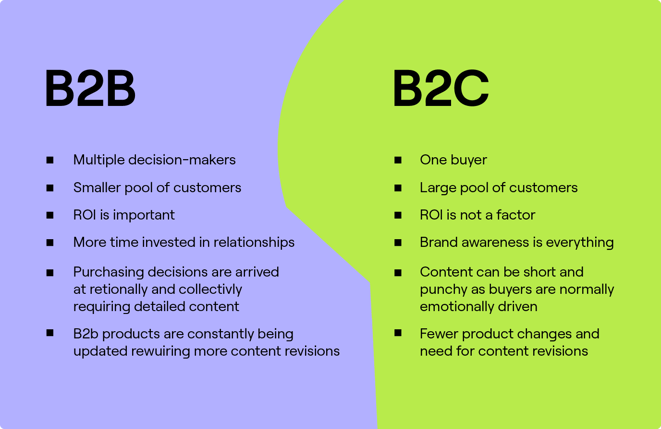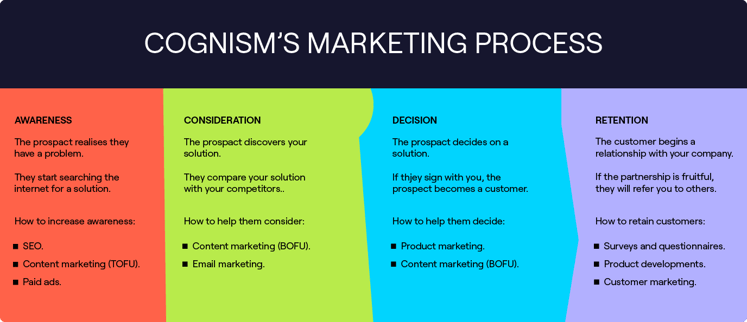What Is B2B Marketing? A Guide to the Best Strategies for 2023
What Is B2B Marketing? A Guide to the Best Strategies for 2023
Mastering B2B marketing can be a challenge.
We’re used to being marketed to as consumers, but try to turn the tables and market to an entire board of key stakeholders… 😨 Let’s not even mention the red tape and all those pain points that need solutions!
But where there’s a B2B business, there’s a way to market to them.
In this guide, we’re covering everything you need to know for business-to-business marketing success, including:
- The definition of B2B marketing
- The differences between B2B and B2C marketing
- The best tried and tested B2B branding strategies
- Examples of B2B businesses doing excellent marketing
- The latest trends to keep on top of if you want to build the best B2B campaigns
B2B marketing meaning | Difference between B2C and B2B | Marketing process | Creating a strategy | Successful B2B marketing examples | Trends for 2023 | Best practices
Let’s start by defining the meaning of B2B marketing 👇
What is B2B marketing?
B2B marketing means business-to-business marketing. It’s any marketing strategy or content used by one business to target and sell to another business. For instance, companies that sell services, products, or SaaS to other companies or organizations typically use B2B marketing.
Two good examples of B2B marketing are Monday.com’s B2B brand strategy on LinkedIn. Another out-of-the-box example is the way Gong plans and executes its Super Bowl adverts. It’s companies like these that sell solutions to help businesses automate or enhance their processes.
The goal of B2B marketing is to attract and convert leads into customers. In the digital age, this means that you need to be able to capture a prospect’s attention quickly and keep it. This can be done through educational content like white papers or value-driven blog posts.
The 6 differences between B2B and B2C marketing
Now that you know the answer to the question, “What’s B2B marketing?” it’s time to look at how B2B and B2C marketing differ.
There are many key differences between B2B vs. B2C marketing, but the most important are the audiences they target:
👉 B2C marketing targets an audience of individual consumers like you and me who are interested in buying products or services for themselves rather than a corporation. B2C companies look at the needs, interests, and challenges of everyday individuals who often buy on a desire or whim rather than waiting for facts to be checked or an expected ROI to be delivered.
Examples of B2C products are anything you might find available in a mall, from toothpaste to t-shirts.
👉 B2B marketing sells to individuals or groups looking to solve a pain point at their company. Examples of B2B products are anything that provides a solution to a challenge, such as sales automation software which makes B2B prospecting easier. B2B marketing funnels and sales funnels are a lot longer as there are more decision-makers who all have a say in the final purchasing decision.
Here’s a rundown of the six major differences between business-to-consumer and business-to-business marketing:

Knowing the differences between potential buyers in B2B and B2C showcases how the tone, targeting, and style of each are quite different. What’s more, demand generation strategies that work for B2B don’t always work for B2C customers, and vice-versa.
🎧 Listen to this episode of Revenue Champions to discover how Udi Ledergor, CMO at Gong, uses B2C tactics for better B2B advertising 👇
The B2B marketing process explained
Before you start strategizing your B2B marketing plan, you should take a minute to first understand the buyer journey. This will help you, as a B2B marketer, improve your customer’s overall experience when interacting with your brand and speed up the buying process.
How can you use the B2B customer journey to improve marketing efforts?
A B2B buyer’s journey is the process potential buyers go through before deciding to buy a new product or service. Their journey will usually consist of three main touchpoints – awareness, consideration, and decision.
At Cognism, we’ve developed our own process for marketing to B2B that’s based on our customers’ journeys.
It’s a process that’s been highly effective in our marketing development representatives (MDRs) generating quality leads and improving their overall experience.
A huge bonus – it creates brand loyalty at the same time! And that’s an incredibly valuable attribute you want going forward.
There are four steps to our marketing process:
1. Awareness stage
- Your buyer realizes they have a problem and starts researching avenues to solve it.
- Intent data can play a big role in your digital marketing here. With it, you can get in front of prospects who are ready to buy and offer them the perfect solution before your competitors do.
2. Consideration stage
- Your buyer puts all of their research together and considers what the best solution to solve their pain points looks like.
- If you didn’t get in front of your potential customers before they started considering solutions, your sales team would need to make a case as to why your service or product is better than your competitors.
3. Decision stage
- The buyer makes a purchase decision for a solution that meets their needs, adds the most value, and fits their budget.
4. Retention stage
- Marketing’s role doesn’t end when customers sign. B2B companies need to build on their current buyer relationships as well as new ones. One example of a B2B marketing effort you can use to achieve this is by using a marketing email signature. You can refresh relationships with relevant content sent via personalized email.
Improve your win rates by right-clicking and saving this informative B2B marketing process template 👇

Once you’ve got your process down, it will be easy to implement an inbound and outbound marketing strategy.
5 strategies you need to add to your B2B marketing plan
The B2B buyer’s journey is unique in that you’re not selling to an individual but to an entire team or group of people, all of whom might have a say in the purchasing decision.
And the journey is no longer simply about prospecting, demoing, and closing. It’s about educating, offering value, and solving pain points.
According to a study done by Forrester on the Three Myths of the “67 Percent” Statistic, 67% of a buyer’s journey is now being done digitally. Your prospects can easily collect information and find what they’re looking for, making it ten times harder for your outbound sales team to influence their decisions.
Your customers are struggling to make these purchases.
This is because there are so many solutions, new technologies, suppliers, and services to consider.
To win sales opportunities, you’ll need to create the ultimate strategy. To help you do that, we’ve got five tips to create the perfect B2B marketing strategies for the business-to-business market:

Here’s a breakdown of each step:
1. Establish your TAM
Start off by outlining your ideal customer profile and TAM. This is an essential part of B2B product marketing and ensures you’re only targeting the right leads for your business.
💡 Tip: If you need help calculating your Total Addressable Market, try our TAM calculator.
2. Decide on your goals
Secondly, set actionable goals for each member of your marketing team. You can stay on top of and optimize your team’s performance by tracking B2B marketing metrics and KPIs.
3. Establish your value proposition
Consider what you can offer prospects that your competitors can’t. Then, decide on your messaging and value drivers for each target audience and key account. (You might be interested in using account based marketing for this.)
4. Plan outreach
Take everything you’ve learned from the above steps and plan your outreach content to drive revenue.
5. Create content
Start creating educational content that drives demand, adds value, and builds brand awareness.
🎬Now that you’ve got your B2B marketing strategy down, here are some tips on closing deals with B2B content 👇
5 examples of strategies for effective B2B marketing
There are several B2B marketing activities, channels, and strategies you can use when marketing to B2B.
Here are five examples of the most important B2B marketing strategies that have been proven to assist in the revenue growth of B2B companies:
1. B2B Campaign marketing
Campaign marketing plays a significant role when marketing to B2B organizations.
It takes a lot of planning before you can execute a campaign selling your product or service. It’s typically conducted through email marketing. Analytics are drawn from the results to measure each campaign’s effectiveness.
👉 Here are four of Cognism’s best B2B marketing campaigns.
Once you’ve had a look at those examples, you’ll want to start planning your campaigns with a template.
2. B2B Content marketing
B2B content is arguably the most important step of a digital marketing strategy.
Online and offline content aids in attracting, converting, and retaining buyers. It typically consists of written, audio, and video content published on an organization’s blog and then shared across its social media channels for more organic traffic.
Organic traffic is a crucial part of a B2B content marketing strategy. You’ll want to invest in hiring a Search Engine Optimization (SEO) expert to get the top result for your product or service when buyers search online. If you don’t already have an SEO expert, then have a look online for some beginner’s guides for SEO.
Whatever you do, just be sure every piece of marketing content stays valuable, informative, and keeps your audience in mind.
👉 Here’s an example of how Cognism creates content worth $88,270 in annual revenue.
3. B2B Digital marketing
Also known as B2B online marketing, digital marketing helps promote your brand so you can better connect with prospects.
Email, social media, paid channels like Google ads, text messages, and influencer marketing all play a part in the digital side of your strategy.
B2B marketers understand that simply posting generic content on social media is no longer an option. Instead, brands are expected to create a social presence building themselves up as experts in their field. If a customer can’t find you on social media, it will result in a lack of trust. That’s why B2B branding is so important.
Many brands are looking to influencer marketing for a brand boost, while others are experimenting with Instagram and TikTok.
👉 For Cognism, LinkedIn has created the best B2B campaign opportunities. Here are five examples of the most effective LinkedIn ads.
4. B2B Performance marketing
Relating to digital marketing, performance marketing combines digital channels with paid advertising, such as Google ads and brand marketing across channels.
Performance marketing allows you to manage your company’s digital advertising spend, generate targeted leads through ads, and build brand engagement.
The preferred channels are Google, LinkedIn, and Facebook.
👉 Here’s a guide that explains how to create powerful Google Ad campaigns for your B2B products.
5. B2B Product marketing
Product marketing generates awareness of a B2B service or product and promotes it at scale. Product marketers are responsible for a product or service’s positioning, messaging, and value proposition.
Customer case studies, webinars, and sales collateral are all approaches to B2B marketing that play a vital part in encouraging business audiences to buy.
To achieve the best results in product marketing, you need to first research your customer’s needs. Then, discover their pain points and ensure each piece of content includes messaging that resonates and offers a solution.
👉 Here’s an example of eight common B2B customer pain points and the messaging Cognism uses to sell a solution.
🎧 Mark Huber, Director of Growth at metadata.io, knows how to make a brand stand out. Listen to this episode of Revenue Champions, where he breaks down his most successful B2B marketing strategies 👇
The major B2B marketing trends for 2023
B2B advertising is constantly evolving – from direct mail and trade catalog ”industrial marketing”, as it was called in 1929, to the launch of smart data, search, and social media marketing. New products and innovative technologies are revolutionizing the way we do business.
The coronavirus pandemic accelerated specific trends, and many thought leaders are looking for new ways of doing digital marketing.
The latest changes to the industry include hybrid working models. virtual events and the rise of video marketing. The dark funnel and Web.30 have also risen up, along with the value of jumping on underpriced attention.
These evolutions will require B2B marketers to become more agile and react more quickly to a changing world and industry. In turn, tracking B2B data will be more important than ever
🔮 Cognism asked marketing leaders about their 2023 marketing predictions.
Watch this video to hear their thoughts 👇
B2B marketing best practices – 6 tips!
B2B marketers need two things to be able to run successful revenue-generating campaigns, and they are:
- An excellent marketing strategy
- Aligning the entire team with best practices
By following best practices, you can ensure your B2B strategy fits your sales goals for a united, more streamlined B2B company.
Here are our 6 best practices for B2B marketing:
1. A plan
All good marketing starts with a plan. First, decide on your goal for each campaign. Then research your target audience before strategizing your way forward.
Once you know what you want to achieve, set B2B marketing KPIs to ensure you stay on the right track. Periodically review your marketing plan against your KPIs. If it’s not working, don’t be afraid to change it.
2. Harness the power of data
Good quality GDPR compliant data is going to do wonders for your account based marketing campaigns.
Firstly, you’ll have access to the right contact information for your prospects, and your B2B marketing campaigns will be more personalized and effective.
Secondly, by using intent data, you’ll be speaking to people who are actually in the market to buy while following your local privacy laws.
Even better, a data-driven marketing campaign helps you make faster and better decisions, reducing spend and lost customers.
3. Create visual content
No one wants to read a blog that’s just long paragraphs of words. Business to business content marketing doesn’t need to be boring!
Spice up your blogs, website, and marketing campaigns with visual assets like videos, GIFs, infographics, and high-quality images.
Visual content encourages engagement with your buyers and strengthens your brand image.
4. Create a brand identity
Speaking of your brand’s image, the best thing you can do for your company is agree and stick to a brand persona.
Brainstorm how you want to be perceived, your values, your tone of voice, and your visual identity.
Customers remain loyal to consistent and transparent brands, so building a brand and creating awareness around it will only increase your position in the B2B market.
One example of B2B marketing in practice is sharing your brand campaigns via your email signature.
5. Focus on pain points
When you know who your customers are, you’re better able to add value to their day-to-day lives.
Buyers no longer want to be sold to; they want to be offered something that can help them solve ongoing frustrations. Swoop in with the perfect answer to their problems and the best B2B marketing solution, and you’ll be their go-to provider of choice for years to come.
6. Experimentation is everything
At Cognism, we’ve learned that the perfect B2B marketing strategy doesn’t exist.
Hard work, perseverance, A/B testing, and experimentation are the tools that will help you thrive in the B2B space.
Another thing to bear in mind is that the SaaS marketing industry is constantly evolving; you need to stay updated on the latest innovations and trends.
Foster an experimental, scientific mindset in your team. Run weekly sprints to launch campaigns quickly and acquire some initial learning for your best chance at record-breaking marketing revenue.
🎧 Francesca Rock, CMO at Kleene.ai, talks marketing best practices, prioritizing marketing channels for distribution, measuring content success, and more in this episode of Revenue Champions 👇
FAQ
What are the 4 types of B2B you can market to?
The 4 types of business buyers you can market to are producers, resellers, governments, and institutions.
Why is B2B marketing important?
There are numerous benefits of B2B marketing – it helps build your brand name across channels. The more business to business customers are aware of your product or service and the value it delivers, the more likely they will be to become customers.
Which social media platform is best for B2B marketing?
LinkedIn, YouTube, Facebook, Twitter, and TikTok are all good lead sources in the B2B market.
Better marketing with tech
B2B marketing solutions have only gotten smarter and more efficient over the years.
Making it even easier than ever before to save time on tasks that used to take hours and hours to do.
One such tool is Cognism, a sales intelligence solution that brings you more quality marketing data – meaning better relationships and more revenue!
And that’s what’s most important, right?
Want to learn more?
Book a screen-share today 👇
















![Toni Kroos là ai? [ sự thật về tiểu sử đầy đủ Toni Kroos ]](https://evbn.org/wp-content/uploads/New-Project-6635-1671934592.jpg)


